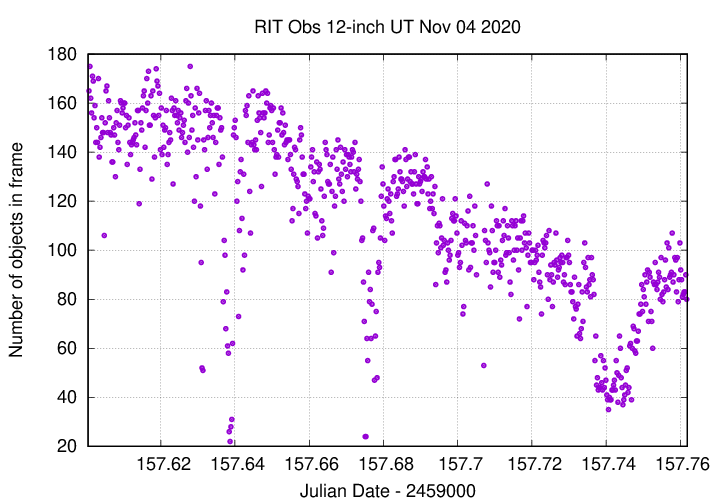
On the night of Nov 03/04, 2020, under fair conditions, I acquired B-band images of the eclipsing variable star RT And, which one of my capstone students will analyze. The star was just coming out of an eclipse at the start of the run.
I noticed that a different, fainter star in the field was _also_ coming out of an eclipse of its own. That star is, as far as I can tell, an un-noticed variable....
You can find some basic information on this star at the SIMBAD's page for it.
The main setup was:
Notes from the night:
The object is at
RA = 23 11 17.9 Dec = +52 59 59.2 (J2000)
A chart of the field based on pictures tonight is shown below. The size of the chart is about 38 x 26 arcminutes.

The stars "A", "B", and "C" appear in the charts and tables for this field made by the AAVSO. see
I used the star labelled A = "102" to shift my measurements to the "B" magnitude scale. It has B = 10.336.
Here's a picture of the TV with the finder's field of view when pointing at RT And:

The dark current was normal this evening:

The sky value shows that the sky was mostly clear, but there were two brief periods of clouds. The low point is when I closed the slit to move the panel to the top of the dome.

The number of objects detected.

I used an aperture of 5 arcsec for photometry. Note the brief rise and fall near the end.

Using aperture photometry with a radius of 5 pixels (binned 2x2, each pixel is 1.25 arcsec, so a radius of 6.25 arcsec), I measured the instrumental magnitudes of a number of reference stars and the target. Following the procedures outlined by Kent Honeycutt's article on inhomogeneous ensemble photometry, I used all stars available in each image to define a reference frame, and measured each star against this frame.
Sigma-vs-mag plots show that the floor was about 0.007 mag with 10-second exposures. I marked all the bright stars as possible variable.

The jumps in the photometric solution are due to clouds.

Here are light curves of the variable and the field stars. Note that RT And is coming out of an eclipse at the start, and that star "X" is doing the same (with a longer egress).

Last modified 11/4/2020 by MWR.